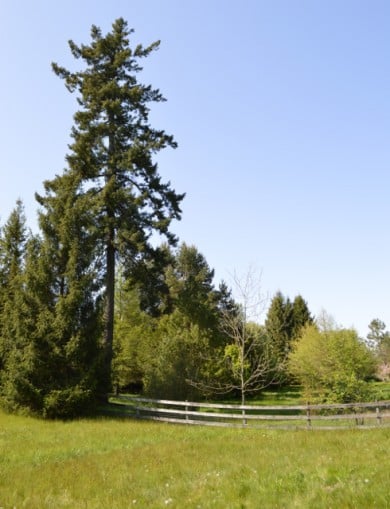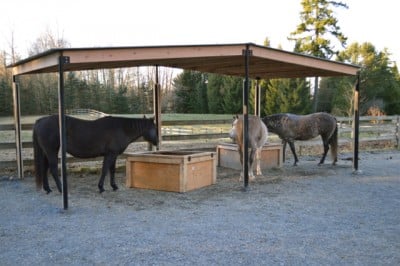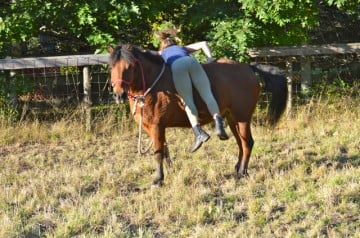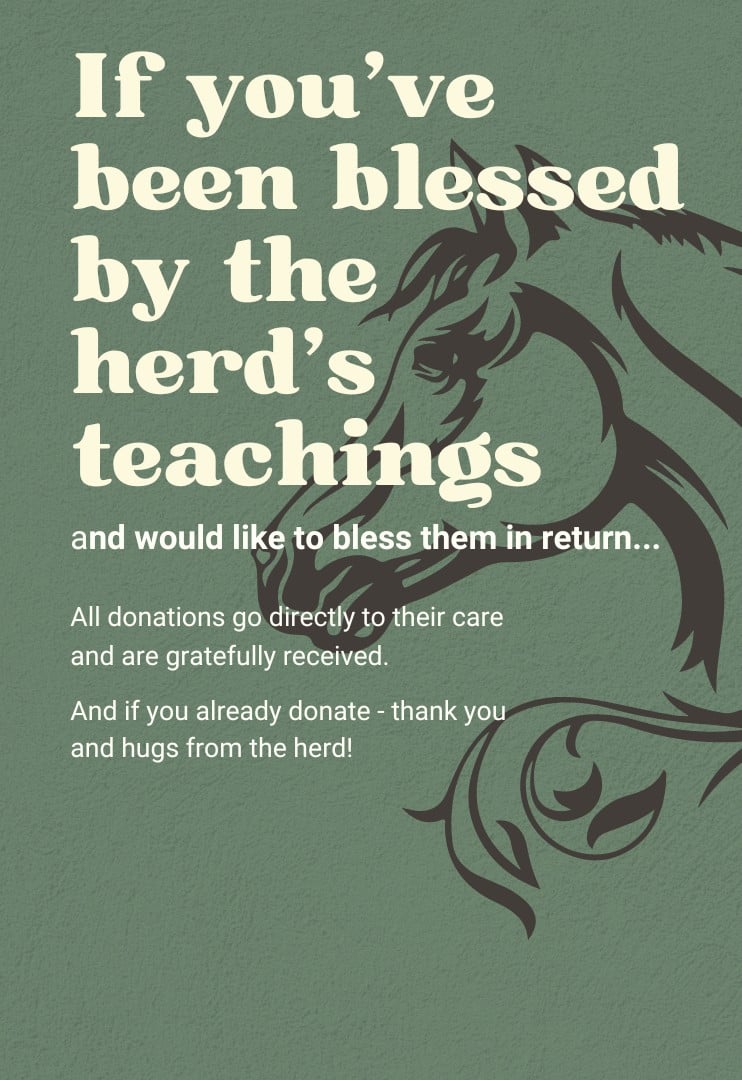
A friend of mine has a donkey and a Welsh pony – both of whom are “easy keepers”. This also means they gain weight easily. And she has 6 acres of beautiful pasture in Langley, BC. Those of you who live here, or in similar climate/soil conditions (Washington state, Oregon, the UK) are already going, “Say no more! It’s dirt paddock time with restricted, scheduled hay feeding only for those two.”
That same friend also has a few Thoroughbreds on that pasture and they can eat all day with no threat of laminitis, founder, or colic – and have been doing so for the last 15 years. Important to note though – in spite of rotating fields – is that there is not enough grass for her Thoroughbreds and she also gives them hay twice per day. Yet in these same conditions, sharing the fields with her Thoroughbreds, her donkey and pony are overweight.
The Plot Thickens
I had a draft/QH cross here in Langley, BC and she was on 2 hay feeds per day in a dirt field. She was being fed more than the amount of hay required for her weight, but she psychologically remained ravenous. Or, was it more than psychological “hunger,” but also a simple matter of acid production, stomach pain and a strong drive to fulfill a biological imperative? Previously, she had been a working trail horse during the summers and turn-out was spent free-foraging on 300 acres in Alberta.
But yet, when she was allowed access to grass here in Langley, BC, she became increasingly arthritic and suffered pain to the point where she didn’t want to move around in her field, which of course led to worsening arthritis. Combined with the cold and damp winter, she was in a miserable state. The place I was boarding her at did not have the option of putting in slow feeders at that time (there were 6 other horses in the field), so that avenue was closed to us.
The other difficulty of having multiple horses fed together on scheduled, restricted feeds (i.e. fed 2 – 4x/day) is that some of them require higher nutrient hay, while others (like mine) required low starch/low sugar hay. So that’s another difficulty to contend with.
In desperation, we agreed with her original owners that the best place for her was in Osoyoos, BC – which has a dry, desert-ish climate – free foraging again on 900 acres. She is once again, happy, mobile, satiated and in good health.
Just to throw one more element into this mix: I had a Morgan/Arab horse and 2 mix-breed ponies on 8 acres of grass (2 fields in rotation) in Edmonton, Alberta for over a decade and none of them suffered founder, laminitis, colic etc. And yes, they got really round and fat every summer.
So what exactly is going on?
Why is it that some horses can handle the very rich, high sugar grass that grows in the lower mainland of BC and other areas of the Pacific Northwest, or the U.K., while others become sick from it?
And since when do horses become ill from eating grass anyway? How could a wild horse survive if that was an issue? It doesn’t even make sense…
The Rainforest Theory

Horses did not roam or naturally exist in this environment (before Europeans began colonizing in 1492), perhaps because it was covered in trees and there was no forage for them to eat!
Perhaps the Indians or settlers who did have horses here after 1774 kept them on relatively small, hand-cleared plots of land and worked them hard all day long. So the amount of high nutrient, high sugar grass they foraged during the hours they were not working was in balance.
Keeping Horses Healthy, Yet Naturally Fed TODAY in the Pacific Northwest
So for those of us who want our horses out in the pasture, with their heads down for extended periods (good for topline, spine, pelvis), having a continual influx of forage (good for that continual acid production in the horse’s stomach)… what can we do?
And what do you do with a horse, pony, or donkey who is already overweight?
First of all, an important point to remember when trying to get weight off a horse/donkey/pony is that their metabolism works the same as ours – if you suddenly cut calories, their body goes into “starvation mode”, slows the metabolism, and holds the fat.
So it’s best to proceed slowly and increase exercise, along with slow-feeding a low sugar/low starch hay. This is one of the best articles I’ve read on this by an equine nutritionist: Restricting Forage Is Incredibly Stressful by Juliet M. Getty PhD.
My horses in Alberta were fed this way (as per the article) and none ever had any issues whatsoever – even had a couple ponies for 4 years and no laminitis, founder, colic, nothing. We never had our hay tested, but I wonder if that dry prairie soil produced a hay that wasn’t so high in sugar?
If allowing for self-regulation is too “unknown” or scary, or you live in an area that produces rich, high sugar grass, then giving the continuous low sugar/starch hay via a slow feeder is an acceptable substitute. Obviously it would restrict intake, but I wondered, would it still produce the hormone cascade and insulin response due to frustration, would the horse still FEEL limited, or anxious…?
Two friends of mine switched their horses to unrestricted hay feeding via hay nets – one was in Langley, BC and the other up in Princeton, BC. And both said it was the best thing they’d ever tried – even with a few “easy keepers” (ie. fast weight gainers) in the herd.
My Solution

I also called Pam Janssen from HayGirl.ca (who specializes in only low sugar hay sourced from farmers in BC, Alberta and Washington) and ordered some of her low sugar Timothy/Orchard Grass mix. What I like about Pam, is that she not only tests for sugar, starch, protein, etc., but also for minerals and trace minerals. This is very important as you need to determine how much iron is in your hay, to prevent your zinc and copper from being out of balance – which also contributes to laminitis, insulin resistance and equine Cushing’s!
I then ordered two of these slow feeder boxes from Olympia, WA – each holds 200 lbs of hay and takes a few minutes to fill. I do not feed ‘grain’, only a vitamin/mineral feed with additional necessary supplements.
The Results
When we began this regimen in the late Fall, my Andalusian had just arrived from New Jersey and she was considerably overweight. Her previous owner had tried to reduce her fat by restricting her hay intake – see the section on metabolism above for why that didn’t work – and had exercised her on a lunge line once per day.
We also had a Curly/Welsh pony in the herd who had also been severely calorie-restricted the previous 2 months, and then later added a Quarterhorse and an Arab/Andalusian cross. All 3 of these horses had also previously been scheduled fed with the amount of hay deemed appropriate for their size/breed.
And yes, as Dr. Getty wrote in the article I linked to above, for the first two weeks they all gorged themselves silly. We made sure those slow feeders had hay 24/7 and never ran out. By the third week the new reality started to settle in and you could see them begin to relax as they realized that the hay was NEVER going to be taken away or disappear, and the slow feeders would never be empty. At that point, they would walk away for a bit, leave the slow feeders, and spend time grooming, or playing.
They had access to the pasture, but as it was winter there wasn’t much grass to be had. But they could still engage in grazing – which is good for both body (structurally) and soul.
Well, all 4 horses did NOT become obese. And the pony and Andalusian naturally slimmed down to normal weight over the next 3 months. My equine chiropractor visited again after only 6 weeks on this new regimen and she said in her entire career she has never seen a horse metamorphose and slim down so fast as my mare. As she had several other clients struggling with laminitic and obese horses, she was very happy to be able to pass on a solution.
Can it really be that simple? Just fill a bunch of slow feeders with low sugar hay?
As long as the rest of your horse’s core nutritional requirements (vitamins/minerals/fats) are being met, yes it can!
Here’s one more tidbit that completely amazed me. One of our mares was in foal, so we brought in some tasty, alfalfa hay for her, so she could have the extra protein as her pregnancy progressed. But all of the horses preferred the low sugar hay to the alfalfa! In the beginning, they just ate the tops of the alfalfa and left the stalks, but after a few weeks, they would even just leave the alfalfa sitting there for a bit, while they munched the low sugar hay. Now that is something I never thought I’d see.
After learning more about amino acids in hay/forage though, I realized that it’s best to feed a little bit of alfalfa daily, ongoing, to all the horses. Since it is a legume (and naturally low in sugar) it contains the amino acids that are missing from hay and grass. Flaxseed (fresh ground is best) also accomplishes this same purpose, if you prefer. This ensures the horse can actually use the protein they are ingesting. Think of what happens to a human vegetarian who doesn’t combine plant proteins to get a complete amino acid profile – same issue.
The Test

So for many months that winter, my horses received whatever hay was available, regardless of sugar level.
Although they were still receiving all their hay in slow feeders or hay nets, my Belgian became very overweight, my Andalusian chubby, and my Belgian/Fjord just a wee bit less chubby. The only horse that did not get fat was my 2-year-old Belgian/Arab.
So you see, it is not enough to just put your hay into slow feeders or hay nets. We also have to ensure we are feeding low-sugar hay – with an NSC of less than 12%.
If you have a horse that was previously malnourished, or had to compete for food, then it is also important to address the emotional/energetic component of scarcity – this will help your horse become balanced and healthy much quicker.
Your Horse Will Be Happy To Go Riding, Play, or Do Groundwork
Another super important benefit of feeding a horse this way (free choice or ad lib hay in slow feeders) is that food becomes less important to them. They stop worrying about when they’re going to eat, because plenty of food is always there. With my mare that was schedule-fed at the boarding facility, I had to schedule the times I came to see her around the feeding times. As you can well imagine, if I showed up within an hour before feeding time, she was very distracted and filled with anxiety about getting back to the field in case she missed the hay drop.
Then, once the hay was given, I had to allow her at least 1.5 – 2 hours to finish eating. For a horse that is living with the constant stomach acid production and anxiety of scheduled (restricted) feeding, the last thing I would do is ask her to come riding or do groundwork, or play with me, instead of eating. That would be crazy and a complete broach of trust in our relationship.
Well, once your horses get used to having 24/7 hay in slow feeders, they lose all anxiety about going off with you, AND they don’t incessantly ask to stop and eat grass along the ride either! It’s such a win-win, you can’t imagine.
And if you want to know how to transition your horse back to grass in the Spring or Summer…

Jini Patel Thompson is a natural health writer and Lazer Tapping instructor. She began riding at age 2 in Kenya, and got her first horse at age 8 in Alberta, and so continues a life-long journey and love affair with these amazing creatures.









Hi Jini – I’ve been researching info on equine permaculture – but most of the information i’ve found is based on farms in Australia. Wondering if you know of or have experience with establishing a permaculture grazing system on small farms (5-6 acres) in the Pacific NW? What trees/shrubs will horses graze when pasture grasses are minimal? And many more questions . . . . Here’s a site that has inspired my quest – but not sure if my geography will allow it. http://equinepermaculture.com
As always – thank you for taking the time to share your experiences and helpful information on horse care and relationships.
Bridget
Working on this now Bridget! Will post here when it’s ready – are you Subscribed (top right)? If so, you’ll automatically be notified via email when I publish it.
Hi Bridget, in case you didn’t see the new post, I’ve just published the equine permaculture article:
https://www.listentoyourhorse.com/equine-permaculture-in-rainy-climates-system-for-sustainable-pastures/
Let me know if I missed anything!